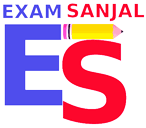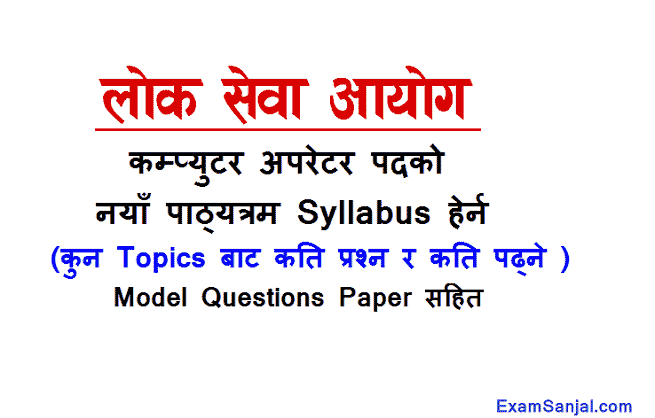Computer Operator Syllabus Lok sewa Aayog. Recently, Lok Sewa Aayog revised the syllabus of Computer Operator. All the New Revised Computer Operator Syllabus are given below. Computer Operator Na Su ( Bibidh Sewa) Technical Na Su Computer Operator New Syllabus by Lok Sewa Aayog.
All the New Update syllabus details of the Computer Operator exam are given below. Non-Gazetted First Level ( Raa Pa Ana Pratham) Computer Operator Syllabus Pathyakram Update. Computer Operator Prabidhik NaSu New Syllabus.
Computer Operator Syllabus First Paper Syllabus Second Paper Syllabus Computer Operator
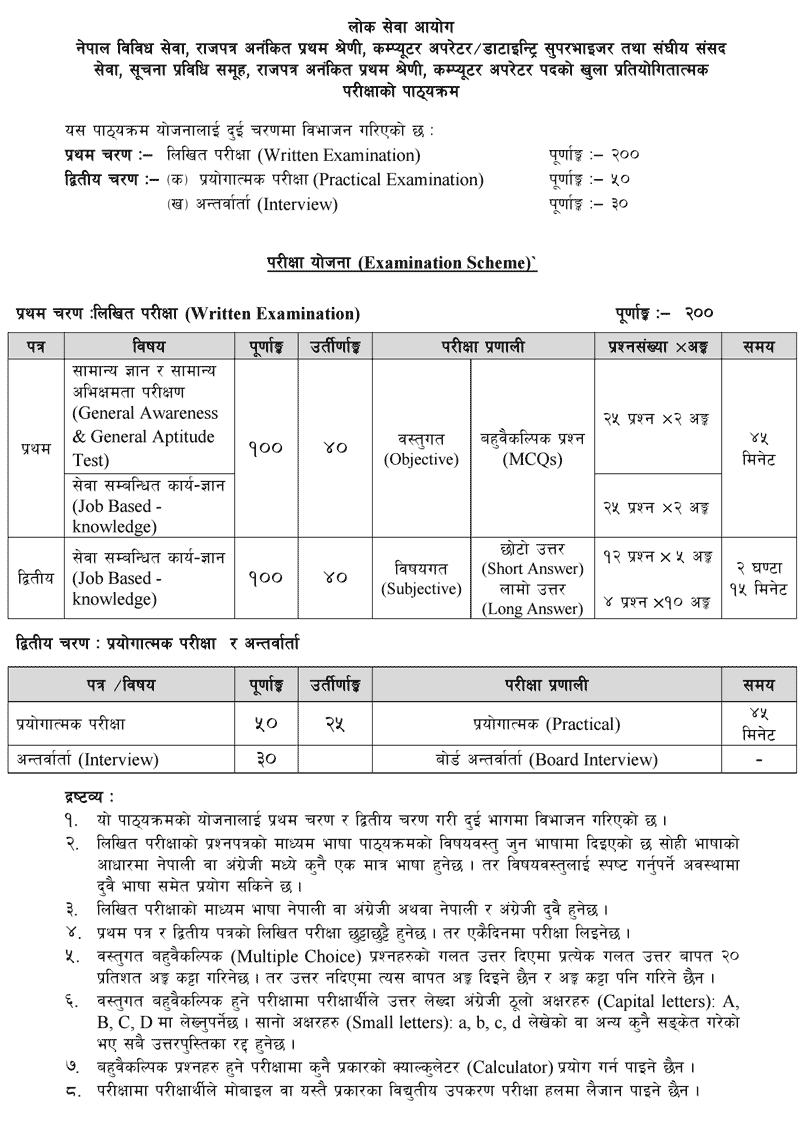
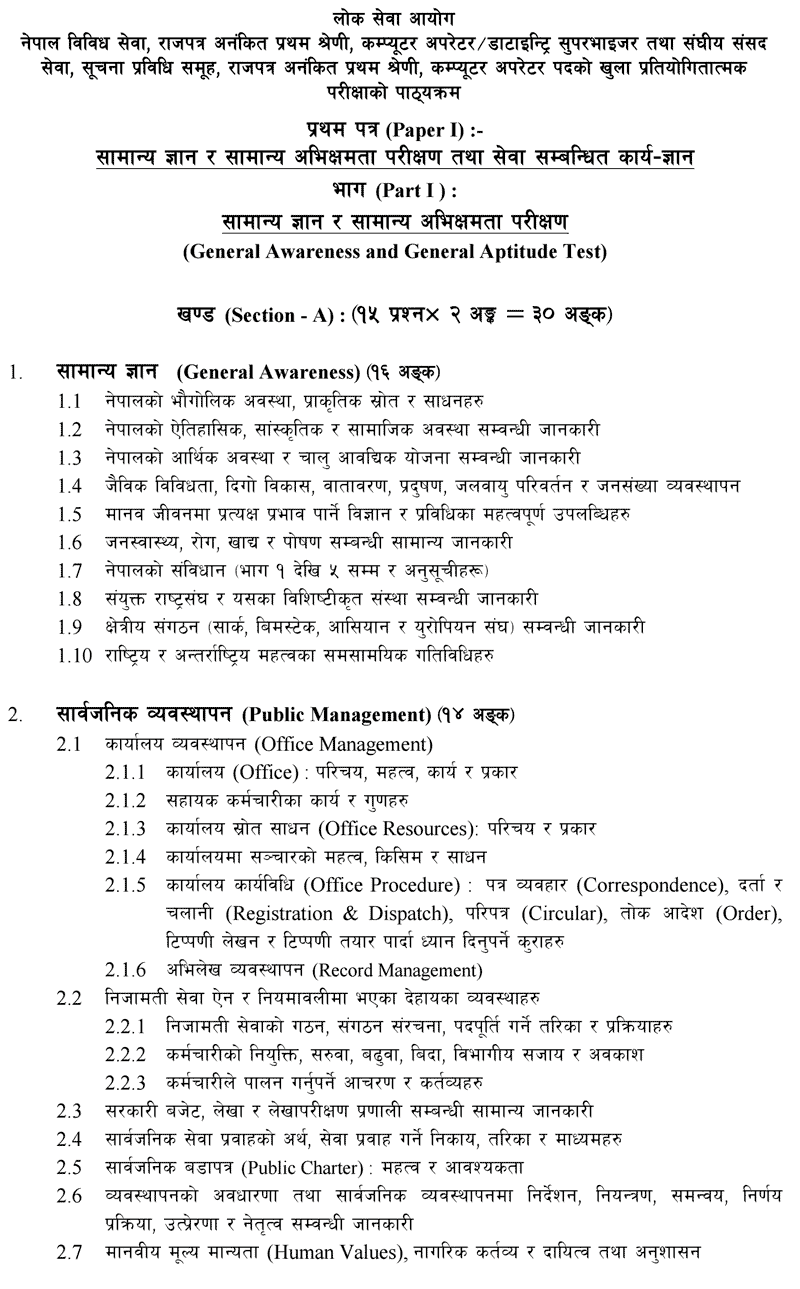
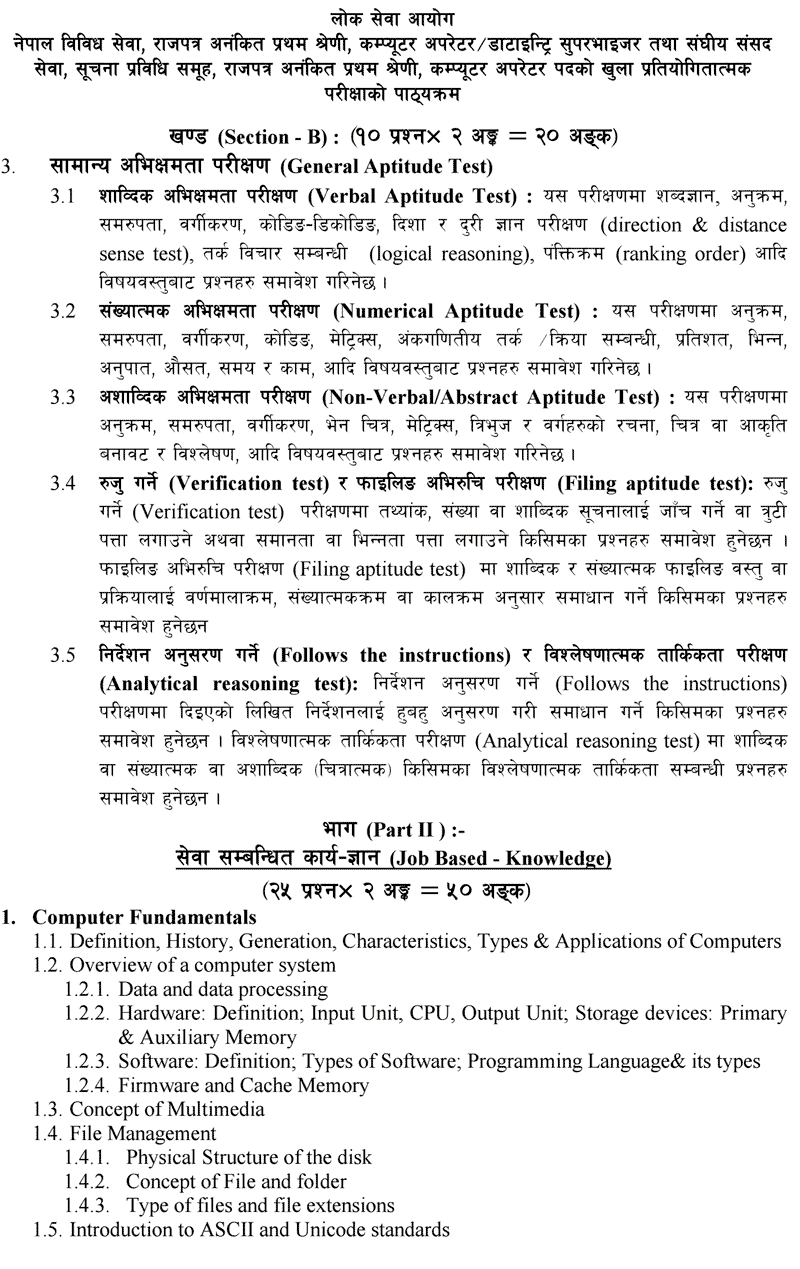
Computer Operator Syllabus Part II Second Paper JOB Based Knowledge
- Computer Fundamentals
1.1. Definition, History, Generation, Characteristics, Types & Applications of Computers
1.2. Overview of a computer system
1.2.1. Data and data processing
1.2.2. Hardware: Definition; Input Unit, CPU, Output Unit; Storage devices: Primary & Auxiliary Memory
1.2.3. Software: Definition; Types of Software; Programming Language& its types
1.2.4. Firmware and Cache Memory
1.3. Concept of Multimedia
1.4. File Management
1.4.1. Physical Structure of the disk
1.4.2. Concept of File and folder
1.4.3. Type of files and file extensions
1.5. Introduction to ASCII and Unicode standards - Operating System
2.1. Introduction to Operating System
2.2. Types of Operating System
2.3. Functions of Operating Systems
2.4. Command Line operation (e.g. copy command, move command, command to view and set different file attributes, etc.)
2.5. Windows Operating System
2.5.1. Introduction to Graphical User Interface (GUI)
2.5.2. Basic Windows Elements – Desktop, Taskbar, My Computer, Recycle Bin,
2.5.3. Starting and shutting down Windows
2.5.4. File Management with Windows Explorer
2.5.5. Windows applications: (Control Panel, Character Map, Paint)
2.5.6. Finding files of folders and saving the result
2.5.7. Starting a program by command line operation
2.5.8. Changing window settings: Adding/Removing programs; Clearing the contents of document menu; Customizing the taskbar; Control panel items
2.5.9. Creating shortcut (icons) on desktop
2.5.10. System tools:disk scanning, disk defragmenter, backup, restore, format - Word Processing
3.1. Concept of Word Processing
3.2. Creating, Saving, Opening, Previewing and Printing documents; Changing Default settings
3.3. Elements of Word Processing Environment (Menu, Toolbars, Status bar, Rulers, Scrollbars)
3.4. Copying, Moving, Deleting and Formatting text (Font, Size, Color, Alignment, line & paragraph spacing); Finding and Replacing text; Setting Page Layout
3.5. Creating lists with Bullets and Numbering
3.6. Creating and Manipulating Tables; Borders and Shading
3.7. Use of Indentation and Tab Setting; Creating Newspaper Style Documents using Column
3.8. Inserting Header, Footer, Footnotes, Endnotes, Page Numbers, File, Page break, Section break, Graphics, Pictures, Charts, Word Art, Symbols &Organization Chart
3.9. Mail Merge
3.10. AutoCorrect, Spelling and Grammar Checking, and Thesaurus
3.11. Security Technique of Documents
3.12. Familiarity with Devanagari fonts
- Electronic Spreadsheet
4.1. Concept of Electronic Spreadsheet
4.2. Organization of Electronic Spreadsheet application (Cells, Rows, Columns, Worksheet, Workbook and Workspace)
4.3. Creating, Opening, Saving, Page Setting, Previewing and Printing Work Book; Changing default options
4.4. Elements of Electronic Spreadsheet Environment (Menu, Toolbars, Status bar, Rulers, Scrollbars)
4.5. Editing, Copying, Moving, Deleting Cell Contents; Formatting Cells (Font, Border, Pattern, Alignment, Number and Protection); Formatting Rows, Column and Sheets
4.6. Using Formula – Relative Cell and Absolute Cell Reference
4.7. Using basic Functions
4.8. Generating Series; Sorting and Filtering Data; Summarizing Data with Sub Totals
4.9. Creating Charts
4.10. Inserting Header and Footer
4.11. Spell Checking
4.12. Importing data from and Exporting into other formats
4.13. Familiarity with Devanagari fonts - Database System
5.1. Introduction to Data, Database and DBMS
5.2. Basic Concept of Tables, Fields, Records, Relationships and Indexing
5.3. Introduction to database application
5.3.1. Data Types
5.3.2. Creating, Modifying & Deleting Tables
5.3.3. Establishing relationships among tables
5.3.4. Formatting and validating field data
5.3.5. Inserting, Modifying, and deleting data
5.3.6. Creating, Modifying, Deleting and Using simple Queries / Forms / Reports - Presentation System
6.1. Introduction to presentation application
6.2. Creating, Opening & Saving Slides
6.3. Formatting Slides
6.4. Slide Show
6.5. Animation
6.6. Inserting Built-in picture, Picture, Table, Chart, Graphs, and Organization Chart etc. - Web Designing and Social Media
7.1. Introduction to Web Page and CMS (Content Management System)
7.2. Designing Simple Webpage with HTML
7.2.1. HTML Document
7.2.2. HTML Tags
7.2.3. Working with Text, Hyperlinks, Images, Lists, Forms, Tables, Frames, etc.
7.3. Familiarity with Cascading Style Sheet, Rich Site Summary and social networking
7.4. Use of Social Media in governance
7.4.1. Introduction to Social Media
7.4.2. Social Media Platforms
7.4.3. Applications in government organizations
7.4.4. Operating and Managing Social Media - Computer Network
8.1. Basic Networking: definition, types, and topologies
8.2. Connectivity and media: Network cables and connectors
8.3. Introduction to Network Devices (Hub, Switch, Router, Gateway etc.)
8.4. Network cabling and cable testing
8.5. Familiarity with IP Addressing, subnet mask, gateway, DNS, static and dynamic address assignment
8.6. Application of Network utilities (e.g. IPCONFIG, PING, TRACERT, NSLOOKUP)
8.7. Concept of E-mail / Internet / Extranet/Intranet, World Wide Web (WWW)
8.8. Familiarity with internet browsers (Internet explorer, Firefox, Opera, Safari, Google Chrome, etc.)
8.9. Familiarity with Cloud-based services (Dropbox, Google Cloud, iCloud, etc.)
- Cyber Security
9.1. Introduction to Cyber Security
9.2. Common security threats: Social engineering; Distributed Denial of Services; Malwares: Phishing, Spyware, Viruses, Worms, Trojans, etc.
9.3. Security Mechanisms
9.3.1. Identity and Access Control
9.3.2. Use of Firewalls, IDS and IPS
9.3.3. Email Filtering
9.3.4. Use of antivirus software
9.4. Digital Signature: Concept and Applications - Hardware Maintenance and Troubleshooting
10.1. Configure Power Supply, Motherboard and System Devices, BIOS settings, input/output devices, UPS
10.2. Types and features of display devices (CRT, LCD, LED, Plasma)
10.3. Connector types (BNC, RJ45, HDMI) and associated cables
10.4. Troubleshooting of computer and its peripherals (keyboard, mouse, printer, scanner, speaker)
10.5. Troubleshooting of connectivity (cables, network, etc)
10.6. Installation and Troubleshooting of operating system (Windows, Linux etc.)
10.7. Installation of Device Drivers, Configuration and Installation of Application Programs and System Restore.
10.8. Data Backup: Concept and Methods - Relevant Legislations and Institutions
11.1. ICT Policy, 2072
11.2. Electronic Transaction Act, 2063
11.3. Information Technology Emergency Response Team (ITERT) Operation and Management Directive, 2075
11.4. Government Website Development and Management Directive, 2078
11.5. Roles of related Institutions:
11.5.1. Ministry of Communication and Information Technology
11.5.2. Department of Information technology
11.5.3. National Information Technology Center / Government Integrated Data Center
11.5.4. Security Operation/Monitoring Center
Computer Operator Syllabus Second Paper Syllabus Topic Wise
- Computer Fundamental – 2 Questions
- Operating System – 2 Questions
- Word Processing – 3 Questions
- Electronic Spreadsheet – 3 Questions
- Database Management System – 3 Questions
- Presentation System – 1 Questions
- Web Designing & Social Media- 1 Questions
- Computer Network- 2 Questions
- Cyber Security- 2 Questions
- Hardware Maintenance & Troubleshooting- 2 Questions
- Related Legislations & Institutions- 4 Questions
- Total Questions – 25
Computer Operator Practical Exam Syllabus Topics
- Devnagari Typing – 5 Marks
- English Typing – 5 Marks
- Word Processing – 12 Marks
- Electronic Spreadsheet – 12 Marks
- Database Management System – 6 Marks
- Presentation System – 5 Marks
- Web page Designing – 5 Marks
- Total Marks – 50
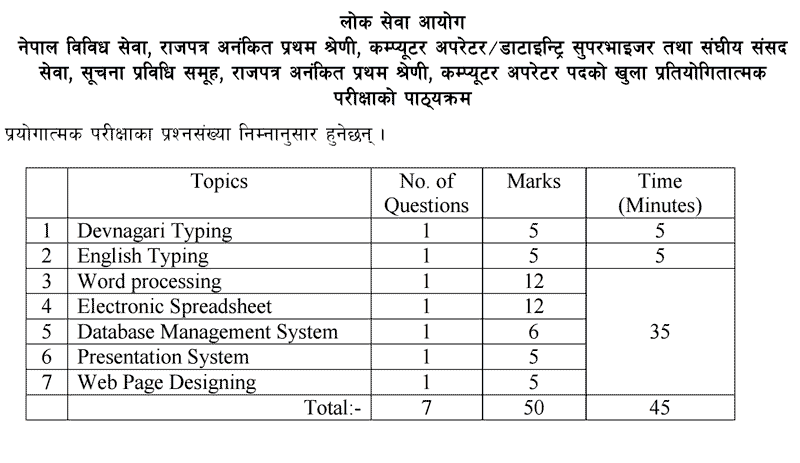
Computer Operator Important Model Questions Answer Lok Sewa
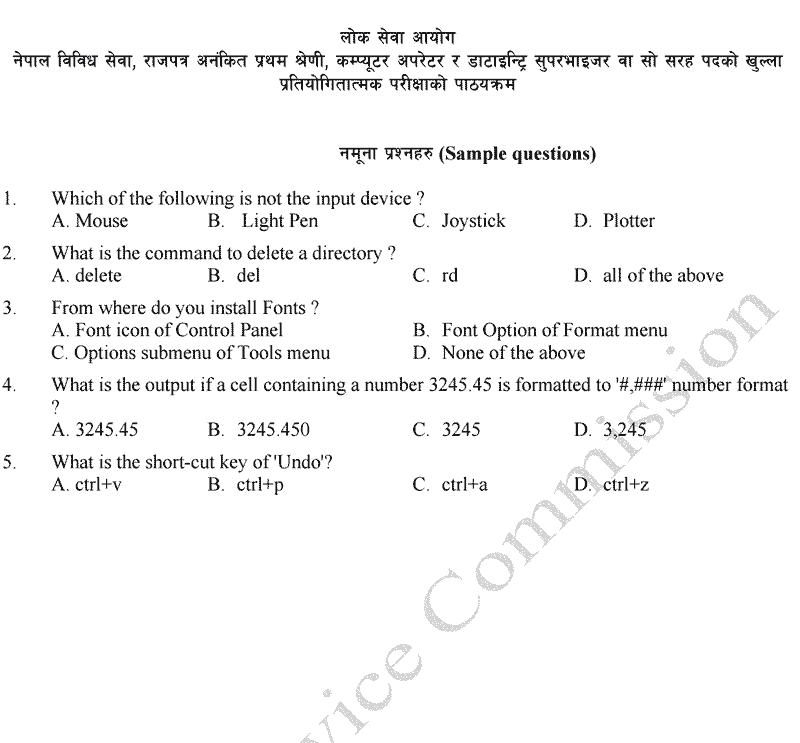
=> View Most Important Model Questions Answer Computer Operator Exams
=> View/ Download PDF Computer Operator Syllabus Lok Sewa
=> Vacancy Notice by Lok Sewa Aayog for Prabidhik Na Su
=> View/ Download PDF Prabidhik Shayak Shiksha Syllabus
Lok Sewa Tayari Exam Sanjal is Free Lok Sewa exam preparation portal for government job exams like nayab subba (naasu),kharidar , Adhikrit Section Officer, Bi Ni, Pra Sa, Bidyalaya Nirikshak, Prabidhik Sahayak, Computer operator and other Nepal Government exam with all Banking Service Exam, Nepal Police Army Service Tayari, Teacher Service Commission Tayari ( Shikshak Sewa Aayog Tayari & Corporation Exam Tayari.
We provides free current affairs 2078, GK, E-Books, Nepali GK, Gorkhapatra loksewa question, loksewa result, online tyari,lok sewa aayog nepal notice,loksewa result, loksewa aayog vacancy 2077, Nepali current affairs 2078, Lok Sewa online tyari, and other online IQ tests available in Nepali and English languages in online video base or blog base in various social media. Lok Sewa Exam Tayari, Na Su Exam Tayari, Kharidar Exam Tayari, Adhikrit Exam Tayari, Bi Ni Tayari, Pra Sa Tayari, Shiksha Sewa Tayari, Shikshak Sewa Tayari, TSC Tayari, Banking Exam Tayari, Corporation Exam Tayari.
Also view:
1. View All Job Vacancy Notice Details
2. View All TU Exam Result Center Update
3. View All Lok Sewa Exam Vacancy Tayari
